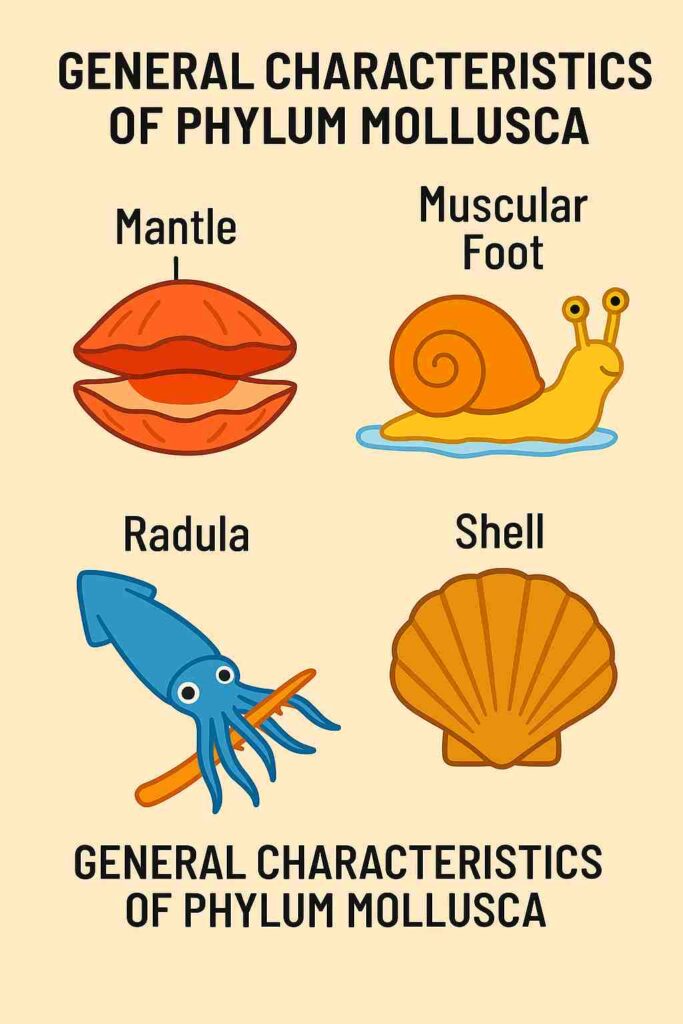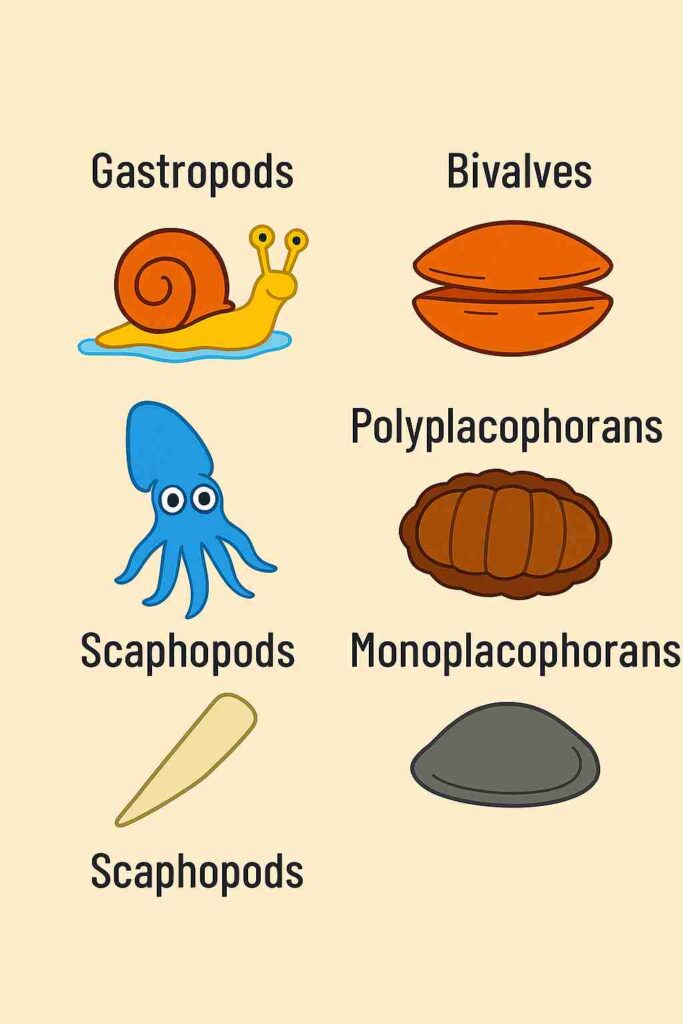What is Phylum Mollusca?

Phylum Mollusca is a diverse group of soft-bodied animals, most protected by hard shells. These creatures include familiar species like snails, clams, octopuses, and squids. They live in oceans, freshwater, and even on land, playing vital roles in ecosystems. Phylum Mollusca share key features: a muscular foot for movement, a mantle that often creates their shell, and (in most) a rasping tongue called a radula. From slow-moving garden snails to intelligent octopuses, this phylum shows nature’s incredible variety in body designs and survival strategies. Their importance extends to human life too – as food sources, water filters, and even inspiration for medical research.
Summary of Phylum Mollusca
- 1. Phylum Mollusca represents one of nature’s most diverse and ecologically vital groups, featuring extraordinary creatures like intelligent octopuses, pearl-producing oysters, and garden snails – each with unique adaptations that showcase evolution’s brilliance.
- 2. With over 100,000 species thriving in oceans, freshwater, and land environments, these soft-bodied wonders play crucial roles in ecosystems by filtering water, recycling nutrients, and serving as key food sources for other animals and humans alike.
- 3. From their medicinal potential to their fascinating behaviors, Phylum Mollusca continue to captivate scientists and nature enthusiasts, offering endless opportunities for discovery about life’s incredible diversity and our planet’s delicate balance.
Table of Contents
General Characteristics of Phylum Mollusca

Phylum Mollusca display some of nature’s most fascinating adaptations. Their soft bodies are typically protected by a hard shell, though some species like octopuses and slugs have evolved without one. This incredible phylum includes creatures as different as slow-moving snails and jet-propelled squids, yet they all share fundamental biological traits that unite them.
1. The Mantle and Its Functions
Every mollusk possesses a specialized tissue layer called the mantle, which plays multiple crucial roles. This fleshy covering secretes the calcium carbonate that forms their characteristic shells in species that have them. The mantle creates a protective cavity housing the gills or lungs, and in aquatic forms, it facilitates water flow for both respiration and feeding. In shell-less mollusks like octopuses, the mantle becomes a muscular cloak used for movement and protection.
2. Versatile Muscular Foot
The molluscan foot is a marvel of evolutionary adaptation, taking different forms across species. Snails glide on a flat, mucus-lubricated foot that leaves their characteristic slime trails. Clams extend a hatchet-shaped foot to burrow into sand or mud with surprising speed. Perhaps most remarkably, in cephalopods like squids and octopuses, the foot has transformed into agile tentacles and a siphon for jet propulsion, demonstrating nature’s ingenuity.
3. The Unique Radula Structure
Most mollusks (except filter-feeding bivalves) possess a radula – a ribbon-like tongue studded with hundreds of microscopic teeth. Herbivorous snails use this biological file to scrape algae from surfaces, while predatory species like cone snails employ modified radular teeth to deliver paralyzing venom. Some marine snails even use their radula to drill through the shells of prey, demonstrating this structure’s remarkable versatility across different feeding strategies.
4. Shell Diversity and Function
Mollusk shells represent nature’s masterpieces of bioengineering. Gastropods produce beautifully coiled shells that grow with the animal, while bivalves create hinged shells that can clamp shut with incredible force. Some species like cuttlefish have internal shells (cuttlebones) for buoyancy control, and certain slugs retain tiny internal shell remnants from their evolutionary past. The variety of shell forms reflects the diverse ecological niches mollusks occupy.
5. Respiratory Adaptations
Mollusks have evolved various breathing mechanisms to suit their environments. Aquatic species typically use ctenidia (feathery gills) that extract oxygen from water, while land snails have developed a vascularized mantle cavity that functions as a primitive lung. Some intertidal species can survive out of water by trapping moisture in their shells, and certain marine mollusks can even extract oxygen directly through their skin in low-oxygen environments.
6. Circulatory System Variations
The majority of mollusks possess an open circulatory system where blood bathes organs directly, but cephalopods have developed a closed system with dedicated blood vessels. This advanced circulatory arrangement supports their active predatory lifestyle and relatively large brains. Interestingly, many mollusks use copper-based hemocyanin instead of iron-based hemoglobin in their blood, giving it a characteristic blue color when oxygenated.
7. Nervous System Complexity
Molluscan nervous systems range from simple nerve nets in clams to highly developed brains in octopuses. The latter demonstrate remarkable intelligence, capable of problem-solving, tool use, and even personality differences. Octopuses in particular possess a central brain plus additional neural clusters in each arm, allowing for extraordinary coordination and sensory processing that rivals some vertebrates.
8. Reproductive Strategies
Phylum Mollusca employ diverse reproductive methods to ensure species survival. Many release clouds of eggs and sperm into the water column, while some gastropods are hermaphrodites capable of reciprocal fertilization. Certain species like the common octopus exhibit semelparity, investing all their energy into a single reproductive event before dying. Other mollusks can change sex during their lifespan, maximizing reproductive opportunities in changing environmental conditions.
These shared characteristics, manifested in countless variations across nearly 100,000 species, make mollusks one of the most successful and ecologically important animal groups on Earth. Their evolutionary innovations continue to fascinate scientists and nature enthusiasts alike, offering insights into adaptation and survival across diverse habitats. From the deepest ocean trenches to mountain forests, mollusks have proven their ability to thrive through remarkable biological solutions.
Classification of Mollusks (Phylum Mollusca)

Phylum Mollusca are divided into seven major classes, each with distinct adaptations that help them thrive in different environments. Here’s a closer look at each group:
1. Gastropods (Snails & Slugs)
Gastropods are the largest and most diverse class, making up about 80% of all Phylum Mollusca. They live in oceans, freshwater, and even on land. Most have a coiled shell for protection, though slugs have lost theirs over time. They move using a muscular foot and feed using a radula—a ribbon-like tongue covered in tiny teeth. Some are herbivores, scraping algae, while others, like cone snails, are venomous predators.
2. Bivalves (Clams, Oysters, Mussels)
Bivalves have two hinged shells that clamp shut for safety. Unlike other mollusks, they lack a head and radula. Instead, they filter tiny food particles from water using their gills. Oysters and mussels help clean aquatic ecosystems, and some even produce pearls when foreign particles get trapped inside their shells. They burrow in sand, attach to rocks, or even swim (like scallops).
3. Cephalopods (Octopuses, Squids, Cuttlefish)
Cephalopods are the most intelligent invertebrates, with large brains and complex eyes similar to vertebrates. They move by jet propulsion, shooting water through a siphon for speed. Many can change color for camouflage or communication using specialized skin cells. Octopuses have eight flexible arms, while squids and cuttlefish have elongated bodies with fins for swimming. Some, like the blue-ringed octopus, are highly venomous.
4. Polyplacophorans (Chitons)
Chitons are armored mollusks with eight overlapping shell plates. They cling tightly to rocks in intertidal zones using their broad, muscular foot. Their radula is reinforced with iron minerals, allowing them to scrape algae off hard surfaces. When threatened, they curl into a ball for protection.
5. Scaphopods (Tusk Shells)
These small, burrowing Phylum Mollusca have a curved, tusk-like shell open at both ends. They live embedded in sandy or muddy ocean floors. Unlike most mollusks, they lack gills and absorb oxygen directly through their mantle. Tiny tentacles called captaculae help them capture microscopic prey.
6. Monoplacophorans
Once thought extinct, these deep-sea Phylum Mollusca were rediscovered in 1952. They have a single, cap-shaped shell and a body divided into repeating segments a rare feature in mollusks. Their anatomy provides clues about early mollusk evolution.
7. Aplacophorans
These worm-like mollusks lack a shell but are covered in spiny scales. Most live in deep ocean sediments and are rarely seen. They feed on tiny organisms and have a simple body structure, making them some of the most primitive mollusks.
Conclusion
From the slow-moving snail in your garden to the brilliant octopus in the ocean depths, mollusks showcase nature’s incredible creativity. Their soft bodies, protected by clever adaptations like shells, venomous tongues, and color-changing skin, prove that strength comes in many forms. Whether filtering water, creating pearls, or solving puzzles, these animals play vital roles in nature and human life. The next time you see a seashell or enjoy seafood, remember you’re encountering one of Earth’s most successful and fascinating animal groups, whose survival secrets have inspired scientists for centuries.
Frequently Asked Questions (FAQs)
How do these soft animals move around?
Mollusks have a special body part called a “foot” that works in cool ways. Snails use theirs like a flat pancake to slide on slime. Clams poke out a pointy foot to dig into sand. Octopuses and squid turned their foot into long arms for swimming and grabbing things. No legs needed – their foot does it all!
Why are octopuses so smart?
Octopuses are the brainiacs of the mollusk world. They have big eyes like ours, a large brain, and each of their eight arms can think for itself! This helps them solve problems, open jars, and even play tricks. Other mollusks don’t need to be this clever because they have shells to hide in.
How do Mollusks help nature?
These creatures are like nature’s little helpers. Oysters clean dirty water by eating the yucky stuff. Snails turn old leaves into good soil. Their shells become homes for small sea animals. Plus, they’re tasty meals for fish, birds, and people too. Without mollusks, many places would be much dirtier and emptier.
Related Articles




